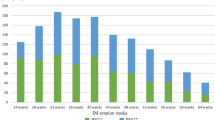Abstract
Background
Experienced medical student educators may have insight into the reasons for declining interest in internal medicine (IM) careers, particularly general IM.
Objective
To identify factors that, according to IM clerkship directors, influence students’ decisions for specialty training in IM.
Design
Cross-sectional national survey.
Participants
One hundred ten institutional members of Clerkship Directors in IM.
Measurements
Frequency counts and percentages were reported for descriptive features of clerkships, residency match results, and clerkship directors’ perceptions of factors influencing IM career choice at participating schools. Perceptions were rated on a five-point scale (1 = very much pushes students away from IM careers; 5 = very much attracts students toward IM careers).
Results
Survey response rate was 83/110 (76%); 80 answered IM career-choice questions. Clerkship directors identified three educational items attracting students to IM careers: quality of IM faculty (mean score 4.3, SD = 0.56) and IM rotation (4.1, SD = 0.67), and experiences with IM residents (3.9, SD = 0.94). Items felt most strongly to push students away from IM careers were current practice environment for internists (mean score 2.1, SD = 0.94), income (2.1, SD = 1.08), medical school debt (2.3, SD = 0.89), and work hours in IM (2.4, SD = 1.05). Factor analysis indicated three factors explaining students’ career choices: value/prestige of IM, clerkship experience, and exposure to internists.
Conclusions
IM clerkship directors believe that IM clerkship experiences attract students toward IM, whereas the income and lifestyle for practicing internists dissuade them. These results suggest that interventions to enhance the practice environment for IM could increase student interest in the field.
Similar content being viewed by others
References
Bodenheimer T. Primary care-will it survive? N Engl J Med. 2006;355(9):861–864.
Sox HC. Leaving (internal) medicine. Ann Intern Med. 2006;144(1):57–58.
NRMP. Advance Data Tables for 2007 Main Residency Match. In: National Resident Matching Program; 2007.
Hirshfeld J Jr., Fye WB. Summary of Task Force recommendations to address the growing shortage of cardiologists. J Am Coll Cardiol. 2004;44(2):272–275.
Hortobagyi GN. A shortage of oncologists? The American Society of Clinical Oncology workforce study. J Clin Oncol. 2007;25(12):1468–1469.
Cravens DD, Campbell JD, Mehr DR. Why geriatrics? Academic geriatricians’ perceptions of the positive, attractive aspects of geriatrics. Fam Med. 2000;32(1):34–41.
Schwartz MD, Linzer M, Babbott D, Divine GW, Broadhead WE. The impact of an ambulatory rotation on medical student interest in internal medicine. The Society of General Internal Medicine Task Force on Career Choice in Internal Medicine. J Gen Intern Med. 1995;10(10):542–549.
Bauer RL, Venkatachalam HM, Forrester RH, Harris GD, Diehl AK. The effect of an ambulatory internal medicine rotation on students’ career choices. Acad Med. 1997;72(2):147–149.
Arora V, Wetterneck TB, Schnipper JL, et al. Effect of the inpatient general medicine rotation on student pursuit of a generalist career. J Gen Intern Med. 2006;21(5):471–475.
Davis BE, Nelson DB, Sahler OJ, McCurdy FA, Goldberg R, Greenberg LW. Do clerkship experiences affect medical students’ attitudes toward chronically ill patients? Acad Med. 2001;76(8):815–820.
Wetterneck TB, Linzer M, McMurray JE, et al. Worklife and satisfaction of general internists. Arch Intern Med. 2002;162(6):649–656.
Whitcomb ME, Cohen JJ. The future of primary care medicine. N Engl J Med. 2004;351(7):710–712.
Dorsey ER, Jarjoura D, Rutecki GW. Influence of controllable lifestyle on recent trends in specialty choice by US medical students. JAMA. 2003;290(9):1173–1178.
Weinberger SE, Smith LG, Collier VU. Redesigning training for internal medicine. Ann Intern Med. 2006;144(12):927–932.
Hauer KE, Alper EJ, Clayton CP, Hershman WY, Whelan AJ, Woolliscroft JO. Educational responses to declining student interest in internal medicine careers. Am J Med. 2005;118(10):1164–11670.
Margo K, Fincher, RE, Espey, E. The role of the clerkship director. In: Fincher RE, ed. Guidebook for Clerkship Directors, 3rd Edition. Alliance for Clinical Education; 2005.
Schwartz MD, Linzer M, Babbott D, Divine GW, Broadhead E. Medical student interest in internal medicine. Initial report of the Society of General Internal Medicine Interest Group Survey on Factors Influencing Career Choice in Internal Medicine. Ann Intern Med. 1991;114(1):6–15.
Stevens J. Principal Components. In: Applied Multivariate Statistics for the Social Sciences. Hillsdale, N.J.: Lawrence Erlbaum Associate Publishers; 1986.
Medical school graduation questionnaire. Association of American Medical Colleges, 2006. (Accessed April 14, 2008, at http://www.aamc.org/data/gq/allschoolsreports/).
Wright S, Wong A, Newill C. The impact of role models on medical students. J Gen Intern Med. 1997;12(1):53–56.
Rosenblatt RA, Andrilla CH. The impact of U.S. medical students’ debt on their choice of primary care careers: an analysis of data from the 2002 medical school graduation questionnaire. Acad Med. 2005;80(9):815–819.
Moore G, Showstack J. Primary care medicine in crisis: toward reconstruction and renewal. Ann Intern Med. 2003;138(3):244–247.
Linzer M, Konrad TR, Douglas J, et al. Managed care, time pressure, and physician job satisfaction: results from the physician worklife study. J Gen Intern Med. 2000;15(7):441–450.
Ricer RE, Van Horne A, Filak AT. Costs of preceptors’ time spent teaching during a third-year family medicine outpatient rotation. Acad Med. 1997;72(6):547–551.
Acknowledgements
We gratefully acknowledge the Clerkship Directors in Internal Medicine Research Committee and staff, and Patricia O’Sullivan, EdD, for statistical assistance.
Funding Support
The Shadyside Hospital Foundation of Pittsburgh, PA, and the American Board of Internal Medicine Foundation.
Conflict of interest statement
None disclosed.
Author information
Authors and Affiliations
Corresponding author
Rights and permissions
About this article
Cite this article
Hauer, K.E., Fagan, M.J., Kernan, W. et al. Internal Medicine Clerkship Directors’ Perceptions About Student Interest in Internal Medicine Careers. J GEN INTERN MED 23, 1101–1104 (2008). https://doi.org/10.1007/s11606-008-0640-y
Published:
Issue Date:
DOI: https://doi.org/10.1007/s11606-008-0640-y




